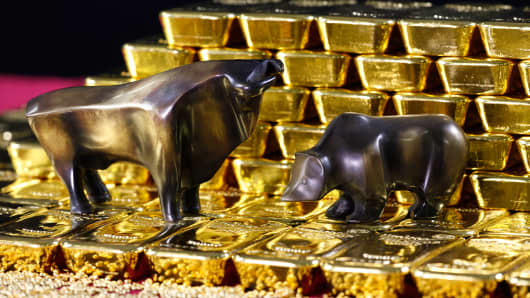The price of gold posted a surprising decline of 1 percent on Wednesday after the Federal Reserve announced its latest bout of bond buying and analysts have told CNBC that gold's mega-rally is in the balance.
The decline in gold is being seen as unusual as more money printing should be negative for the dollar and positive for gold. Gold prices had hit a two-week high of $1723 on Wednesday before the Fed decision, but on Thursday gold traded around $1695 in the Asian session.
"The temptation to lock-in profits as we near year-end was strong," analyst Joni Teves at UBS said in a research note. "But despite the decline of as much as $25 in Asia, we don't think the sentiment towards gold has actually turned negative."
The fact that the fall happened overnight meant it was Asian sellers forcing the price lower, according to Teves, where liquidity is an issue.
Traders quoted by Reuters gave a range of reasons, putting the dip down to stop-loss selling and people suddenly deciding to liquidate their positions.
"This announcement is a bit confusing to gold investors as it linked policy to unemployment, etc.," a Tokyo-based trader told the news agency. "Perhaps the market wanted unlimited QE."
The Federal Reserve announced on Wednesday that it will buy $45 billion in additional treasurys every month, on top of the $40 billion of mortgage-backed securities it already purchases, taking the total size of its QE program to $85 billion a month.
The central bank also indicated it would keep interest rates near zero until the unemployment rate falls to at least 6.5 percent.
(Read More: How Significant Are the Fed's Targets?)
Gold has risen 9 percent this year and has surged around 400 percent in the last decade. Often seen as a hedge against inflation it also traditionally has an inverse relationship to interest rates; gold demand increasing when rates are low.
But the rules surrounding the price of gold have changed, according to Michael Derks, chief strategist at FXPro. His research shows that it can no longer be seen as having a negative correlation with global real interest rates or even with the dollar.
"Many are seeing further quantitative easing measures from the Fed this week giving gold an added boost, but this could struggle to be the case," he said in a research note on Tuesday, adding that even if the dollar fell after the Fed announcement, gains for gold would be limited.
"For the gold bulls to remain in the ascendancy next year, a lot will depend on the much feared inflation from global quantitative easing starting to show through. It's proving to be a long wait though," he said.
Bob Parker, head of the strategic advisory group at Credit Suisse also said gold has stalled at this level and he doesn't see it rising till 2014.
"We'll have to wait for the next leg up in inflation," he told CNBC.com. "The Fed announcement was at least partly discounted and the statement emphasized the lack of inflation which was why the bond sell off was minor and the reaction on gold was negative."
(Read More: Gold to Hit $2,000 by January: Analysts)
Gold's defensive properties should be supportive of the price given the threats to the nascent global recovery, according to Martin Arnold, senior research analyst at ETF Securities.
"Moving into 2013, the environment is still very positive for gold given the ultra-loose monetary policy and the lack of political cohesion within the euro zone," he said.


